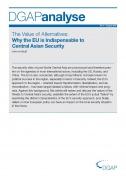Abstract
The security risks of post-Soviet Central Asia are pronounced and therefore present on the agendas of most international actors, including the US, Russia, and China. The EU is also concerned, although it has hitherto not been known for political success in the region, especially in terms of security. Indeed, the EU’s approach to the region – oriented toward transformation, liberalization, and democratization – has been largely labeled a failure, with minimal impact and progress. Against this background, this article will review and discuss the nature of the threats to Central Asia’s security, establish the extent of the EU’s actual “failure” by examining the distinct characteristics of the EU’s security approach, and, finally, reflect on how European policy can have an impact on the local security situation in the future.
Introduction
In post-Soviet Central Asia – the region spanning Kazakhstan, Kyrgyzstan, Tajikistan, Turkmenistan, and Uzbekistan – a host of economic and geopolitical opportunities come face to face with pressing security challenges. A region steeped in tradition, Central Asia has long served as a land bridge and transport route connecting Asia, the Middle East, and Europe. It has substantial and sought-after raw materials at its disposal, from hydrocarbon and water resources to ferrous and non-ferrous metals, among other commodities. Moreover, the countries of Central Asia serve as comparatively loyal allies to the international community in efforts to stabilize Afghanistan, through their participation in the Northern Distribution Network (NDN). At the same time, however, the region faces substantial threats to domestic and transnational security: flourishing transnational crime (notably arms and drug trafficking), governmental and social instability, and growing “Islamization” of the traditionally secular populations. In this regard, a pronounced role in inciting regional instability is often attributed to neighboring Afghanistan, which has become even more fragile and prone to Islamic extremism since the withdrawal of the International Security Assistance Force (ISAF) in 2014.
Central Asia’s most influential neighbors are two of today’s significant non-Western powers: Russia and China. Although their approaches differ – Russia pursues a prominent political-military role in the region, while Beijing focuses on the developmental aspects of security – both actors consider Central Asian security to be a priority, particularly in terms of protecting the region from possible spillover from instability to the south. To this end, both “authoritarian great powers” maintain close bi- and multilateral ties with Central Asia’s equally authoritarian states, aiming to stabilize the local regimes – in other words, to consolidate the local political status quo.
The subject of Central Asian security is important to the European Union as well. Like Russia and China, the EU regards the possibility of (Afghanistan-induced) Islamic extremism and the ensuing radicalization of post-Soviet Central Asia’s traditionally secular populations as key threats to regional security. Like the strategies of Russia and – especially – China, moreover, the EU’s Central Asia Strategy is marked by a developmental approach, with particular emphasis on building social, economic, and technical capacity. The EU’s progress report on Central Asia, echoing the Chinese approach of enhancing security through development, states that “EU interests in the Central Asian region are best served by promoting comprehensive security and development, which are interlinked and mutually reinforcing.”
Despite the outward similarity of objectives (regional security and stability) and approaches (capacity building and socio-economic development), however, there is a pronounced factual discrepancy between Russian and Chinese engagement on the one hand, and European engagement on the other. This is because the EU, unlike Russia and China, views its efforts to create regional security through a liberal-democratic lens, putting particular focus on the human dimension and the transformation of local authoritarian structures – something that, prima facie, is profoundly out of tune with the survival instincts of Central Asia’s post-Soviet governments and their powerful neighbours.
This article explores whether and to what extent the EU’s distinct “transformation-oriented” approach impedes its security ambitions in Central Asia. The objective here is to assess the potential for European impact in a region that is in many ways quite adverse to the “import” of Western norms and to investigate whether and how the EU may contribute to security and help the region’s governments address local instability. The remainder of the analysis will elaborate on these issues. It will discuss threats coming from Afghanistan as well as locally bred dangers; put these into the context of the EU’s Central Asia Strategy; highlight, in turn, the latter’s potential for impact on local patrimonial-authoritarian structures; and, in conclusion, reflect on the European ability to influence the local security situation for the time to come.
Read the full text here.

